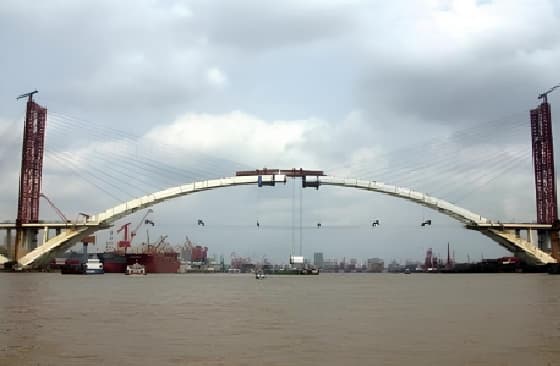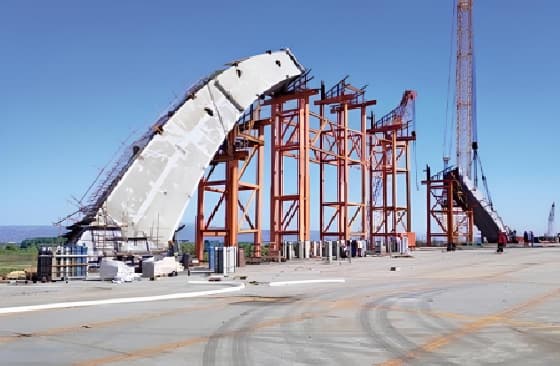Introduction
Steel arch bridges, with "arch rib bearing" as the core, are classified into three types: half-through type (main arch located in the middle of the bridge deck), through type (main arch located under the bridge deck), and basket-handle arch (arch ribs inclined inward). The arch ribs adopt box sections (height 3-9m, width 2-5m), and the tie bars are divided into rigid (steel box) and flexible (steel strand) types, with the main span ranging from 80m to 550m.

They feature strong load-bearing capacity, high structural rigidity, convenient construction, and good aesthetic performance, making them widely used in transportation infrastructure such as urban roads and railways. They are suitable for crossing complex terrain areas like deep valleys, large rivers and streams.

Case 1: Lupu Bridge in Shanghai
Lupu Bridge is a half-through steel arch bridge.It has a main span of 550 m,a total length of 750 m,and a width of 29m.The main bridge is made up of steel.It has six lanes and a design clearance of 46m between the deck and the river.The main arch is composed of 9m(deep)x5m(wide)box girders,which were the biggest in the world at the time of construction.From fabrication perspective,it was the first in the world,which used welding exclusively,except that bolted connections were used between the bridge segments.

Case 2: Xiaohe Bridge in Taiyuan
The main bridge is a spatial skew symmetrical arch, with a span arrangement of 65+110+110+65=350m and a width of 45m. The main bridge consists of arch ribs and longitudinal girders. The girders are semi-closed bilateral steel box sections with a depth of 4.0m at the centerline.
The girders are consolidated with the arch ribs by the large transverse beams. The main bridge consists of a main arch, two cambered auxiliary arches,and connecting transverse beams.With a span of 225m, the main arch spans diagonally from the southeast side of the main bridge to the northwest side. The secondary arches are on the east and west sides ofthe main bridge, which span 110m. A total of 14,000 tons of steel was used.

Case 3: East Ring Expressway Wohe Bridge in Anhui
The total length of the bridge is 629m. The 145m long main bridge is a through-type steel box tied arch structure. The bridge deck has eight lanes with a total width of 51m. The main bridge is a beam-arch combination system. Steel box sections were used for the arch rings and the longitudinal girders. The ties are a combination of rigid and flexible members. The arch rib system is composed of arch ribs, top wind bracings,and other components.A total of 6,600 tons of steel was used.
(1)Outstanding styling aesthetics: The arch rib features a smooth curve, with customizable basket-handle, special-shaped and other configurations to meet the needs of urban landmarks.
(2)High structural efficiency: The arch structure converts vertical loads into axial forces, with a material utilization rate 20%-30% higher than that of beam bridges with the same span.
(3)Navigation-friendly: Spanning the river in one continuous span, the main arch boasts a high clear height at the lower chord and requires no piers in the water, making it suitable for Class Ⅰ-Ⅱ waterways.


Q1: Can the main arch of a steel arch bridge achieve a "single-span crossing of River"? What are the maximum span limitations?
A1: The feasibility of a steel arch bridge achieving a "single-span crossing of the Yangtze River" depends on the river width and structural design: if the river width is ≤ 600m, a half-through steel box arch can be adopted, combined with open caisson foundations to bear horizontal thrust. If the river width exceeds 600m, a "steel arch + cable-stayed" composite system (such as main arch + auxiliary stay cables) is required; otherwise, the cross-section of the arch rib will be excessively large, leading to reduced economic efficiency.
Q2: How to control the welding deformation of steel arch bridges? What are the precision requirements for on-site assembly?
A2: Welding deformation is controlled through "process optimization + jig fixing": ① In the factory, the "reverse deformation method" (presetting a reverse deformation of 2mm/m) and "symmetrical welding" (multiple welders welding simultaneously) are adopted, followed by hydrogen elimination through heat preservation at 250℃ for 1 hour after welding; ② On-site assembly uses total station + BIM positioning, with the arch rib alignment error ≤ 3mm/m and the segmental butt gap ≤ 2mm.

International Department: Room 2507-2508, Tower C of Wanda Plaza, Tongzhou District, Beijing 101118, China.
+86-13021287080
info@boyoun.cn